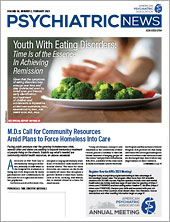Technological advances such as digital apps and consumer search engines have made it possible for people to access medical information at the click of a button. However, how do consumers know if the information they access is valid?
At APA’s 2022 Mental Health Innovation Exchange, Megan Jones Bell, Psy.D., a clinical psychologist, creator of the digital platform Lantern, former chief science officer at Headspace, and director of consumer and mental health for Google, led a discussion in an attempt to answer this question.
She explained that at the start of her career as a clinical psychologist in academia who focused on technology-based preventative care, she grew frustrated because anything she built that was evidence based was inaccessible to the people who needed it.
In response to this need in 2012, Jones Bell created Lantern, a comprehensive platform that promoted mental health prevention and treatment with targeted interventions that were all evidence based. The intent of Lantern was to plug in evidence-based information and care to systems where people in need existed—for example. at universities. However, this model of care was unsuccessful because, as she said, “Companies, at that point, were not paying for university-based in-person prevention services outside of those which were included in their commercial insurance.”
At the time, there was a gap between the demand for valid information and supply due to lack of support and resources. To address this gap, Jones Bell proposed a five-pronged approach to partnerships: consumer-based platforms; authoritative information; supportive accountability; high-quality, engaging content; and evidence-based self-assessments.
Partnering with consumer-based platforms such as Google, YouTube, and Pinterest allows for quick access to information, according to Neha Chaudhary, M.D., a double board-certified child and adolescent psychiatrist and chief medical officer at BeMe Health.
“I did some work with colleagues from our Stanford Lab for Mental Health Innovation where we worked with companies like Pinterest, for example, to co-develop products for digital mental health that are now rolled out worldwide, and the whole idea was that we would meet people where they were,” she said. “And all those people were not coming to see us in the clinic, but they were on Pinterest. So, that’s where we went to create impact.”
For these consumer-based partnerships to be reliable and to ensure the promotion of accurate information, Jones Bell introduced a second key factor in the five-pronged approach: authoritative information.
Authoritative information is evidence-based information established by dependable third parties. In the case of Jones Bell, as the director of consumer and mental health for Google, she partnered with trustworthy organizations such as the National Academy of Medicine, the World Health Organization, and the Royal Academy of Physicians to define authoritative health sources. She then created specific policies to draw out medical misinformation and provided direct access to credible research sources on platforms such as YouTube and the Mayo Clinic.
The websites of Mayo Clinic and YouTube now indicate health information that comes from an accredited health care organization. This way people looking for health information can clearly see whether the source they have found is credible.
The third key principle highlighted by Jones Bell was supportive accountability. This is the idea of partnering with experts in the field such as psychologists and physicians. This partnership provides professional medical consensus behind any health-related decision made on consumer-heavy platforms such as Google.
So far, partnerships with consumer-based platforms, third-party sources of authoritative information, and expert supportive accountability help to bridge the gap in care. However, stigma and patient experience validation are important factors that require attention. That’s why partnering with consumers is a vital component of the five-pronged approach.
Jones Bell explained that the way to address stigma is to create personal, high-quality, and engaging content by partnering with individuals with lived experience. She stated: “When we think about stigma, it’s really important to hear from people with whom you relate, to hear that message in a way that is a personal story that speaks to your cultural experience, your lived experience.”
The last facet of the five-pronged approach is partnering directly with the individual who is looking for information. Jones Bell proposed that this can be accomplished by having consumers complete easy-to-access evidence-based self-assessments. Following completion of the assessment, the website should help them understand their score, link them to authoritative resources, and offer suggestions of where they can find further help depending on their needs. This relationship helps people understand that their unique experiencing is valid.
Outlined in this five-pronged approach are key insights to creating valuable partnerships that can lead to effective, accessible, high quality, evidence-based care at the click of a button.
These suggestions were only a handful of propositions shared at the 2022 Mental Health Innovation Exchange on providing easy access to reliable care through partnerships. More information about the future of mental health technology will be presented at APA’s 2023 Annual Meeting in May. Look for more information in a future issue. ■


